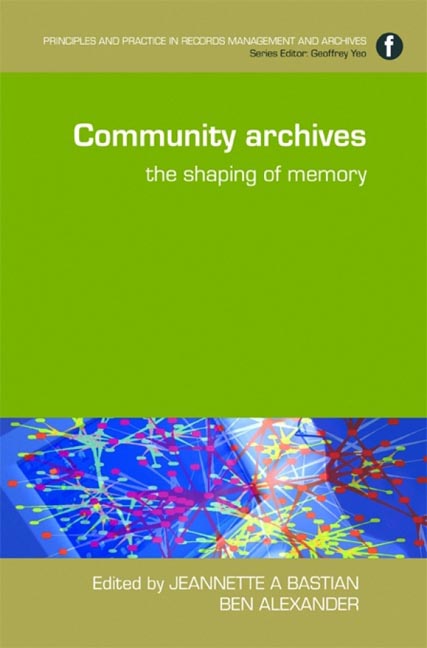Book contents
- Frontmatter
- Contents
- Introduction to the series
- Acknowledgements
- Contributors
- Introduction: Communities and archives – a symbiotic relationship
- Part 1 A community archives model
- Part 2 Communities and non-traditional record keeping
- Part 3 Records loss, destruction and recovery
- Part 4 Online communities: how technology brings communities and their records together
- Part 5 Building a community archive
- 11 ‘All the things we cannot articulate’: colonial leprosy archives and community commemoration
- 12 Overcoming anonymity: Kittitians and their archives
- 13 Always queer, always here: creating the Black Gay and Lesbian Archive in the Schomburg Center for Research in Black Culture
- Conclusion: The archivist and community
- Bibliography
- Index
- Miscellaneous Endmatter
- Miscellaneous Endmatter
- Miscellaneous Endmatter
13 - Always queer, always here: creating the Black Gay and Lesbian Archive in the Schomburg Center for Research in Black Culture
from Part 5 - Building a community archive
Published online by Cambridge University Press: 08 June 2018
- Frontmatter
- Contents
- Introduction to the series
- Acknowledgements
- Contributors
- Introduction: Communities and archives – a symbiotic relationship
- Part 1 A community archives model
- Part 2 Communities and non-traditional record keeping
- Part 3 Records loss, destruction and recovery
- Part 4 Online communities: how technology brings communities and their records together
- Part 5 Building a community archive
- 11 ‘All the things we cannot articulate’: colonial leprosy archives and community commemoration
- 12 Overcoming anonymity: Kittitians and their archives
- 13 Always queer, always here: creating the Black Gay and Lesbian Archive in the Schomburg Center for Research in Black Culture
- Conclusion: The archivist and community
- Bibliography
- Index
- Miscellaneous Endmatter
- Miscellaneous Endmatter
- Miscellaneous Endmatter
Summary
Introduction
In the fall of 2007 a young New York University student named Sarah visited the Schomburg Center for Research in Black Culture to view materials in the Black Gay and Lesbian Archive (BGLA), a project I founded a decade ago to aid in the preservation of Black queer culture and history. As I placed several boxes on the table before her, Sarah's beautiful brown face lit up like sunshine. She was ecstatic about sifting through the stacks of Black queer books of various genres dating from the mid-1970s to the present.
‘My brother and I were talking earlier about there being no Black gay culture. That there were only a few Black gay writers like James Baldwin and E. Lynn Harris’, she said beaming. Watching as she handled the books, opening and reading parts, her eyes large and smile broad, I shared her enthusiasm. Through Sarah's experience, I recognized myself, small and yearning, recalling that itch for knowledge about Black queerness that became the impetus for the formation and development of the Black Gay and Lesbian Archive.
Behind the archive
Toledo, Ohio, circa 1982. Much like any other black Midwesterner, I was born to working-class people who were products of a post-industrial town in a post-Civil Rights moment. My parents sought to raise children who would live better than they did. Racial equality trumped gay and lesbian rights. The Black Power and the Black Arts movements dictated the clothes we wore, the way we talked, the movies we saw, and even what we read. Most Black communities dealt primarily with achieving civil rights and upward mobility. By contrast, the reality of gay and lesbian life and culture was complicated. Since everyone knew somebody who was or suspected to be ‘that way’, homosexuality was tolerated in some sense. There were no specific neighbourhoods for Black queer people because Black people could not afford to, or did not want to, live away from other Black people. Neighbourhoods, schools and churches and anywhere else Black heterosexuals lived, learned or prayed, homosexuals were there, and they too lived, if quietly.
As a teenager, my thirst for a language to describe what I thought I was or at least was becoming ravaged my consciousness.
- Type
- Chapter
- Information
- Community ArchivesThe shaping of memory, pp. 235 - 250Publisher: FacetPrint publication year: 2009
- 2
- Cited by



